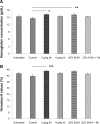Chronic khat (Catha edulis) and alcohol marginally alter complete blood counts, clinical chemistry, and testosterone in male rats
- PMID: 24348075
- PMCID: PMC3858587
- DOI: 10.2147/JEP.S46635
Chronic khat (Catha edulis) and alcohol marginally alter complete blood counts, clinical chemistry, and testosterone in male rats
Abstract
Introduction: Khat (Catha edulis) is a recreational psychoactive drug with psychostimulant properties. While the use of this drug is widespread in eastern Africa, including the Horn of Africa, surveys and anecdotal data show that its use has become cosmopolitan, with users now living in Europe and North America as well. Recent data in Uganda suggest an increasing pattern of simultaneous khat and ethanol use particularly among young adults. However, the effects of this pattern of use remain largely unknown, even though long-term use of either drug alone is known to be harmful. The aim of this study was to examine the toxic effects of simultaneous chronic administration of khat and ethanol on hematological parameters, clinical chemistry, and testosterone in a rat model.
Methods: Adult male Sprague-Dawley rats were randomly assigned to one of six dose groups: 2 g/kg khat; 4 g/kg khat; 4 g/kg ethanol; combined khat and ethanol (4 g/kg each); control; and an untreated group. Treatments were given by gavage twice daily for 28 days, followed by determination of hematological parameters, blood clinical chemistry, and testosterone.
Results: Ethanol alone significantly reduced platelet counts compared to control-, untreated and low-dose khat-treated rats; conversely low-dose khat significantly increased both the hemoglobin and hematocrit values, while ethanol alone also significantly increased the hemoglobin value compared to controls. Simultaneous khat and ethanol administration per se did not produce more toxic consequences in chronic use than either drug alone.
Conclusion: Chronic short-term khat use and ethanol dependence individually produce note-worthy effects on the blood, but not on clinical chemistry or testosterone. Chronic short-term combined khat and ethanol use does not produce more toxic effects compared to use of either drug alone. This provides an opportunity for appropriate clinical interventions to avert the chronic long-term effects that result from use of these drugs of abuse.
Keywords: chemistry; chronic; ethanol; hematology; khat; testosterone.
Figures







Similar articles
-
Khat (Catha edulis) and ethanol co-dependence modulate seizure expression in a pentylenetetrazol seizure model.J Ethnopharmacol. 2011 Oct 11;137(3):1431-6. doi: 10.1016/j.jep.2011.08.017. Epub 2011 Aug 17. J Ethnopharmacol. 2011. PMID: 21871549
-
Effect of Catha edulis foresk (khat) extracts on male rat sexual behavior.J Ethnopharmacol. 2007 Mar 21;110(2):250-6. doi: 10.1016/j.jep.2006.09.019. Epub 2006 Sep 26. J Ethnopharmacol. 2007. PMID: 17079105
-
Proconvulsant effect of khat (Catha edulis) in Sprague dawley rats.J Ethnopharmacol. 2009 Jan 30;121(3):476-8. doi: 10.1016/j.jep.2008.10.037. Epub 2008 Nov 8. J Ethnopharmacol. 2009. PMID: 19056477
-
Khat (Catha edulis Forsk) - And now there are three.Brain Res Bull. 2019 Feb;145:92-96. doi: 10.1016/j.brainresbull.2018.07.014. Epub 2018 Jul 27. Brain Res Bull. 2019. PMID: 30059706 Review.
-
Chemistry, pharmacology, and toxicology of khat (catha edulis forsk): a review.Addict Health. 2011 Summer-Autumn;3(3-4):137-49. Addict Health. 2011. PMID: 24494129 Free PMC article. Review.
Cited by
-
Evaluation of immunomodulatory activities of methanolic extract of khat (Catha edulis, Forsk) and cathinone in Swiss albino mice.BMC Immunol. 2015 Feb 22;16:9. doi: 10.1186/s12865-015-0072-5. BMC Immunol. 2015. PMID: 25879529 Free PMC article.
-
Projection neurons in the cortex and hippocampus: differential effects of chronic khat and ethanol exposure in adult male rats.J Exp Pharmacol. 2016 Oct 13;8:43-52. doi: 10.2147/JEP.S114272. eCollection 2016. J Exp Pharmacol. 2016. PMID: 27785113 Free PMC article.
-
Toxic Effect of Khat in Rat Embryos and Fetuses.Biomed Res Int. 2021 Jul 29;2021:9933389. doi: 10.1155/2021/9933389. eCollection 2021. Biomed Res Int. 2021. PMID: 34368361 Free PMC article.
-
Catha edulis Forsk and Ascorbic Acid Effects on Hematological Indices in Rat.J Blood Med. 2021 Sep 25;12:855-862. doi: 10.2147/JBM.S328703. eCollection 2021. J Blood Med. 2021. PMID: 34602828 Free PMC article.
-
Studies on the ethnopharmacology, antimicrobial activity, and toxicity of Catha edulis (Vahl.) Endl., in Sprague Dawley rats.F1000Res. 2022 Aug 18;11:286. doi: 10.12688/f1000research.109243.2. eCollection 2022. F1000Res. 2022. PMID: 37767078 Free PMC article.
References
-
- Al-Samarraie M, Z Khiabani H, Opdal MS. Khat – a new drug of abuse in Norway. Tidsskr Nor Laegeforen. 2007;127(5):574–576. Norwegian. - PubMed
-
- Nencini P, Ahmed AM. Khat consumption: a pharmacological review. Drug Alcohol Depend. 1989;23(1):19–29. - PubMed
-
- Ihunwo AO, Kayanja FIB, Amadi-Ihunwo UB. Use and perception of the psychostimulant, khat (catha edulis) among three occupational groups in south western Uganda. East Afr Med J. 2004;81(9):468–473. - PubMed
-
- Anderson D, Beckerleg S, Hailu D, Klein A. The Khat Controversy: Stimulating the Debate on Drugs. Oxford: Berg Publishers; 2007.
Grants and funding
LinkOut - more resources
Full Text Sources
Other Literature Sources

